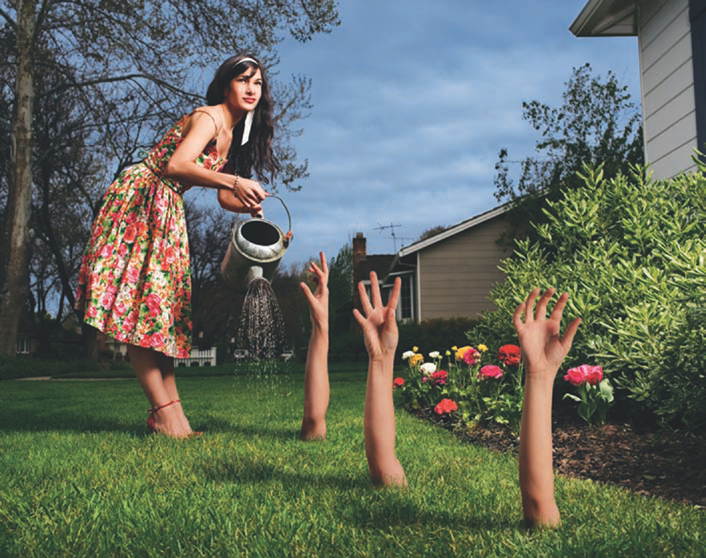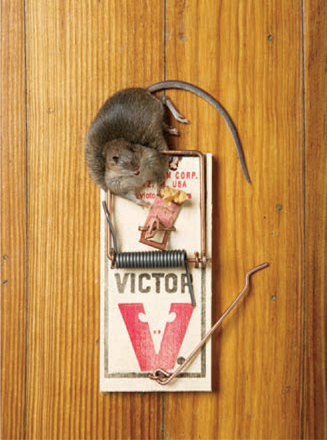

PHOTO: HENRY BLACKHAM
WORST-CASE SCENARIO: YOU PRESENT YOUR PORTFOLIO FOR REVIEW AND THE POTENTIAL CLIENT ASKS, “SO WHAT TYPE OF WORK DO YOU DO?” YOU DON’T KNOW HOW TO RESPOND.
WORST-CASE SCENARIO: YOUR PORTFOLIO IS ENTIRELY SELF-PRODUCED AND THE VIEWER ASKS, “SO WHAT WAS THIS SHOT FOR?”
Honesty is always the best policy, so in both scenarios your answer should be something like, “I have found that most clients did not hire me for the work that I love to shoot, so I decided to shoot a body of work that reflects a wider range of my talents.”
The lesson from these two scenarios is that you should shoot what you love. What you shoot should be an extension of who you are as an artist.
This chapter is about your identity as a photographer—what it is that is uniquely you. Once you understand your uniqueness, you are on the way to developing your style.
If you were asked to describe your work, what would you say? I shoot food? I shoot still life? I shoot people? I shoot lifestyle?
Even if you are a generalist who shoots in a variety of genres, all of your work must feel the same—the viewer must sense that the same person shot all of the work. You can shoot products, food, locations, and people, but the images must all be unified by your personal style.
A style is what makes you unique. It separates you from your competition. According to Ray Behar, Creative Director at Draft FCB, “Style is a photo-grapher’s visual signature that is different from any other. It’s akin to a fingerprint or DNA.” Ray goes on to reflect on the importance of a photographer’s style: “In my mind, style is as important to a photographer as his production skills. What makes me choose a photographer is that his overall talent best expresses the idea I want to shoot.”
Carolee Coker, Art Director at IMI, considers style from another perspective: “Style is what makes you get that phone call.”

PHOTO: AUGUST BRADLEY
PHOTO: AUGUST BRADLEY

PHOTO: AUGUST BRADLEY
The most important element for success is a style that is distinctly yours. August Bradley spent time creating his style before marketing his work.
Having a style means that you stand for something. A style helps the creative person in an organization hire you with the confidence that you will successfully execute their concept.
Think about it: When you shoot what everyone else shoots, you are only increasing your competition. If your images look like everyone else’s, your work gets less attention. But when your work is unique—that is, if it has a distinctive style—it stands out and that creative person is going to want only you.
If a company is looking for someone to shoot its executives on location around the world and you offer what everyone does, it is 100 percent guaranteed that the client will opt for the lowest bid. But if you offer the ability to capture executives in a natural manner in their own environment and the client wants to stand above his competition, he will pick you and work with you on the budget.
The pressure to perform and create something wonderful for your portfolio can be great. However, if you sit and worry and try to figure out some fabulous shots you could make and then stew and worry some more, you will not be able to create freely.
Instead, shoot, shoot, shoot—and capture something special. Don’t think about your portfolio. Just shoot what you love instead of shooting for your portfolio.
PHOTO: JAMES QUANTZ

PHOTO: JAMES QUANTZ
James Quantz works in a special style that takes a subject to an elevated level.
Here are some ideas to help you get motivated:
» Look through a magazine and be inspired. The photographic topics, concepts, and styles that appear in magazines are what is happening in today’s market. Look at the layouts and the production values and try to replicate them—but with your own vision and style.
» Go out and look around. Find an object and let it inspire you. Go to the mall or walk down a busy street and look at the signs and billboards around you—these are the materials that companies are using to advertise to consumers. A great deal of test marketing and focus group work went into those displays to get folks to buy.
» Regularly jot down ideas in a notebook or carry a small point-and-shoot camera. Capture moments that you can re-create later in a set-up situation. We call these “free images” or “gifts from the photo gods.”
» Capture any scenarios that strike you, ranging from a child having a temper tantrum to the gentleness of a youngster reacting to a grandparent, or even a beautifully prepared meal in a restaurant. Go out and shoot everyday life.
» If you come across an item that you think will one day add to a really cool shot, buy it and hold on to it. A funky lamp can really spice up the background of a shot. Find a mask to add that “something extra” to a shot and create a mood. Use a plain, old, everyday piece of pottery to hold a simple food item and make a shot stronger.
» Work with a talented crew. Collaborating with stylists and models—people you or your friends know or whom you hook up with through networking—can help establish shots for your portfolio that look well produced. Many crews will work on the barter system, trading their time for images to use in their own books.

PHOTO: ISTOCKPHOTO.COM
Look around and find an everyday object that inspires you to create a beautiful image.

PHOTO: RACHEL COLEMAN
Rachel Coleman takes an ordinary object and creates something special. In this situation she shoots something that is both elegant and simple.

PHOTO: RACHEL COLEMAN
In this shot, Rachel takes her process further. She adds a sexy element, removing the leaves to show the heart of the artichoke.

When you see this antique menu (a campy photo of dishes of food imprinted on a tray), what comes to your mind? Are you inspired to shoot food styled as though it’s from this era—maybe eggs and bacon making a smiley face or a ’50s-style diner with a waitress dressed to match? Look at things around you and allow them to inspire you with ideas for photographs.
PHOTO: TINA WILLIAMS
Find a subject while you are out and about, let that scenario provoke an emotion in you, then re-create that emotion.
Sometimes a little honest dialogue with yourself can help clarify what you need to do to move forward. Start with these questions:
Photographers generally come from one of two backgrounds. They either went to photography school or are self-taught. For doing studio work, no one is better just because they went to photography school. Many self-taught photographers are extremely successful.
An art buyer will never ask you for a resume or a diploma from the school you attended. Your work as shown in your portfolio and on your website is your resume.
PHOTO: COLBY LYNSE

PHOTO: COLBY LYNSE

PHOTO: COLBY LYNSE

PHOTO: COLBY LYNSE
When Colby Lysne wanted to break away from assisting and shoot full-time, he worked on his portfolio before approaching the market. He created a body of work that represented him and what he wanted to be hired to shoot. Although he wondered whether he could do corporate work, he listened to his consultant and stayed true to what he wanted to do. Currently Colby is represented by a national rep firm and getting the assignments he wants to do—in other words, he is getting paid to do what he loves.
If your answer to this question is, “A lot of money,” change careers immediately. Most successful photographers are in the business mainly because they love the art of photography, and their passion is evident in their images. This is what really brings in the business. People want to work with positive and passionate photographers. Remember: Photography is an art form, and people hire you for your artistic vision.
If your answer is no, then you need to assess where you want to go and how to make the changes that will get you there. Who do you ask? Friends? Will they really be honest? Your spouse? Are they as frustrated as you are with your career status, and will they respond honestly?

FORMS AND TEMPLATES FOR YOUR USE
Throughout this book you’ll find images of and discussions about documents that photographers can use in their planning (worksheets, a budget template, a calendar) or their work with clients (an estimate questionnaire, property and talent releases, a budget overage report). These, plus many more—a total of 21 forms and templates—are available for download. See Appendix B for a list of all the documents and concise instructions about how to use them.
The questions on this worksheet may help you focus on what you need to do to get your career on track. Click here to download a PDF version of the Photographer Worksheet.

A consultant is a creative person who helps photographers in many different areas of their work. What does a photographic consultant do? Perhaps most important, a consultant will guide you as you work to establish your own, distinctive style.
A consultant also will typically help select images for your website, printed portfolio, e-mail images, and mailers, and guide you in acquiring or compiling a database and creating a plan for your marketing.
A few words about two other types of support professionals a photographer can hire:
» Artist’s representatives work to get their clients assignments. They market, represent, and estimate jobs, and some reps even final-bill the jobs their clients do. In return for the rep’s time and marketing expertise, photographers give them a percentage of their creative fees from assignments and, of course, pay the costs incurred by the rep for promotional pieces, couriers and shipping, and travel.

PHOTO: SCOTT B. SMITH
Scott Smith’s existing logo and website presentation looked dated, as though they were from the 1980s—not the look he wanted. It’s important to look around and see what is current.
PHOTO: SCOTT B. SMITH/DESIGN BY TAMERA HANEY/BLISS DESIGN BOUTIQUE
When Scott Smith worked with designer Tamera Haney, this was the outcome—a great site-opener screen that is fresh and clean and invites the viewer in. Scott’s logo now looks current. His site showcases his work in a manner that meets industry standards for style and content.
» Designers, usually hired on a freelance basis, create marketing brands and design approaches for photographers. You can hire them for a particular project or work with them on a retainer basis, which means you can call on them for any or all of your design needs at any time.
While consultants can differ in their styles and approaches, in the end a consultant should give both creative and marketing advice to help you move your career forward. Even if you have an agent or work with a designer, a consultant can be an asset to your marketing and portfolio and website presentations.
The best consultants are the ones who have been in a creative field—as an art buyer, an art director, or a photographer’s rep—so that they understand what photographers need to do to make their work stand out, and then how to market themselves properly.
Some consultants are better than others at counseling you on what direction to take in your career, while others are strictly editors. Yet other consultants may even coach you on what to shoot to extend your portfolio.
Before you hire someone to help you with your career, interview several candidates to find the one you think will work best with your needs and personality. It’s like any other close relationship: Will the two of you be a good fit? While some consultants will give you details about their past clients, others don’t like to “kiss and tell.” Even without trying to elicit specific information, you should ask about their past successes and request examples of those successes.
Also ask about a consultant’s experience with your style of photography. How will he or she be able to help you? If the response is “That will cost you,” you have to decide whether you want to continue the conversation. Prospective consultants should be willing to have a five- to ten-minute phone chat with you about your work.
Two of the most important questions a consultant should ask are, “What made you call and what do you want to change?” Let’s face it, you wouldn’t be calling if you didn’t need to change something.
One of the best ways to gauge where you are right now is to sit down and ask yourself these questions: Where have I been? Where am I now? Where do I want to go? The answers will help you and the consultant of your choice get you on the right path.
Do you have the capital to make the leap? Are you willing to invest in a brand identity for your portfolio and website and promotional materials? Consultants’ fees vary. You could spend anywhere from $200 (for a quick evaluation of your current website) to $2,000 for help designing a new site, creating new branding, and carefully guiding you in creating new mailing materials. We have actually heard of a photographer who spent more than $5,000 for the services of a consultant.
There are many consultants all over country who offer a variety of views and experiences that may be of benefit to you. Here, starting with our own names, is a list of consultants we recommend.
»Amanda Sosa Stone. Resource guide owner, former rep, art buyer, and assistant to Elyse Weissberg. www.sosastone.com
»Suzanne Sease. Former art buyer at several regional, national, and international ad agencies and in-house corporations. www.suzannesease.com
»Susan Baraz and Rhoni Epstein. www.phototherapists.com
»Ellen Boughn. Also a stock consultant. www.ellenboughn.com
»Leslie Burns-Dell’Acqua. Former rep. www.burnsautoparts.com
»Louisa Curtis. Former source book rep. www.chatterboxenterprises.com
»Deanne Delbridge. www.deannedelbridge.com
»Jennifer Kilberg. www.fluidvisioninc.com
»Selina Maitreya. www.1portauthority.com
»Andrea Maurio. Editorial consultant. www.andreamaurio.com
»Carolyn Potts. www.cpotts.com
»Monica Suder. Great career coach. www.monicasuder.com
»Ian Summers. Former creative director. www.heartstorming.com
»Debra Weiss. www.debraweiss.com
»Allegra Wilde. www.allegrawilde.com
PHOTO: NICK ONKEN

PHOTO: NICK ONKEN

PHOTO: NICK ONKEN
Nick Onken is constantly shooting. Regardless of what he shoots, his style crosses over into the many categories he features on his website.

» Question
How have you stayed positive for the last two years?
» Answer

I stay positive with encouragement from my consultant and by shooting new work all the time. Shooting new work keeps me fresh, inspired, and creatively fulfilled. Of course, we have to make money and pay the bills, but being creatively fulfilled is the main reason we should be doing this job. If we do that right, we will get hired for jobs that give us that creative satisfaction. Having that as a goal to push for is the best way for me to stay positive.
—NICK ONKEN
Up-and-coming photographer who has landed a Nike campaign and an international rep

» Question
Have you seen any direct impact on the work you get from the marketing you do?
» Answer
Marketing has taken me to the next level. I’ve been doing regular e-promo campaigns consistently, as well as a few direct-mail campaigns. I think it gets your name out there more in a branding perspective. The more people see your name, the more they will start to recognize it. In addition to mass marketing, I regularly schedule meetings and try to meet at least two new industry people a month and show them my book.
—NICK ONKEN,
Photographer


SLOW AND STEADY
Being properly prepared means being consistent for the first year. You know the old saying: Slow and steady wins the race. Spread out your efforts, and don’t do everything all at once. Let your budget dictate what you can afford to do. Once you start marketing, plan to continue marketing for the rest of your career.

PHOTO: NICK ONKEN
Nick makes sure his images work with his branding. He e-mails images that reflect the work he is trying to get.

» Question
How does someone who is unknown get work?
» Answer
Establish relationships with art directors and art producers. Take the time to do some research to find clients you think you would match well with, then target that organization and those who work there. Get yourself some PR through your name being shown in editorial work and award shows and contests. Getting your name out there is so important, yet for some people it seems to be an afterthought. One person sent me work I loved and didn’t even include his or her name. And including your name on your portfolio as a handwritten scrawl of squiggles doesn’t help. That name is not going to be burned into my mind.
—JESSICA HOFFMAN,
Senior Intergrated Art Producer, Crispin Porter + Bogusky, Boulder
